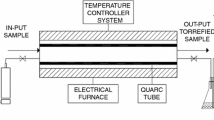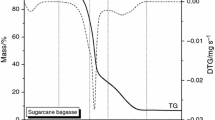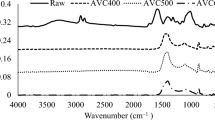Abstract
In this research, combustion properties and kinetics of different biomass samples known as poplar wood, hazelnut shell and wheat bran were studied using thermogravimetry–mass spectrometer. Experiments were performed at three different heating rates (10, 20 and 30 °C min−1) under air atmosphere. The reaction regions, peak and burnout temperatures, mass loss, maximum mass loss rate and residue of the biomass samples were determined. It was observed that all the biomass samples studied show similar combustion characteristics. This study was also focused on the main volatile products (H2, O, CO and CO2, etc.) of biomass combustion on the basis of their relative intensities across the temperature range 150–750 °C and on their relevancy, respectively. Activation energy and Arrhenius constant of the biomass samples were calculated using two different iso-conversional methods, known as Ozawa–Flynn–Wall and Kissinger–Akahira–Sunose. It was observed that the activation energy values were in the range of 66.80–68.56 kJ mol−1 for poplar wood, 83.73–93.25 kJ mol−1 for hazelnut shell and 162.17–167.4 kJ mol−1 for wheat bran, respectively. The biomass reactivity is directly related to the light volatile content, whereas combustion of fixed carbon affected the energy release.






Similar content being viewed by others
References
Houghton RA. In: Jorgensen E-CSE, Fath B, editors. Encyclopedia of ecology. New York: Academic; 2008. p. 448–53.
Lim CH, Lam H. Biomass demand-resources value targeting. Energy Convers Manag. 2014;87:1202–9.
Loo SV, Koppejan J. The Handbook of biomass combustion of co-firing. Sterling: Earthscan; 2008.
Basu P. Economic issues of biomass energy conversion. Energy Convers Manag. 2013;75:25–43.
Jayaraman K, Gokalp I. Thermal characterization, gasification and kinetic studies of different sized Indian coal and char particles. Int J Adv Eng Sci Appl Math. 2014;6:31–40.
Jayaraman K, Gokalp I. Pyrolysis, combustion and gasification characteristics of miscanthus and sewage sludge. Energy Convers Manag. 2015;89:83–91.
Magdziarz A, Wilk M. Thermal characteristics of the combustion process of biomass and sewage sludge. J Therm Anal Calorim. 2014;114–2:519–26.
Coimbra RN, Paniagua S, Escapa C, Calvo LF, Otero M. Combustion of primary and secondary pulp mill sludge and their respective blends with coal: a thermogravimetric assessment. Renew Energy. 2015;83:1050–8.
Wilk M, Magdziarz A, Kalemba I, Gara P. Carbonisation of wood residue into charcoal during low temperature process. Renew Energy. 2016;85:507–13.
Kok MV, Ozgur E. Thermal analysis and kinetics of biomass samples. Fuel Process Technol. 2013;114:739–43.
Ozgur E, Miller BG, Miller SF, Kok MV. Thermal analysis of co-firing of oil shale and biomass fuels. Oil Shale. 2012;29–2:190–201.
Gasparovic L, Korenova Z, Jelemensky L. Kinetic study of wood chips decomposition by TGA. In: 36th international conference of SSCHE, May 25–29, 2009, Slovakia.
Seo DK, Park SS, Hwang J, Yu TU. Study of the pyrolysis of biomass using thermogravimetric analysis (TGA) and concentration measurements of the evolved species. J Anal Appl Pyrol. 2010;89–91; 66–73.
Slopiecka P, Bartocci P, Fantozzi F. Thermogravimetric analysis and kinetic study of poplar wood pyrolysis. In: 3rd international conference on applied energy, May 16–18, 2011, Italy.
Qing W, Hao X, Honpeng L, Chunxia J. Thermogravimetric analysis of the combustion characteristics of oil shale semi-coke-biomass blends. Oil Shale. 2011;28–2:284–95.
Kumar A, Lijun W, Yuris A. Thermogravimetric characterization of corn stover as gasification and pyrolysis feedstock. Biomass Bioenergy. 2008;32:460–7.
Mansaray KG, Ghaly AE. Determination of reaction kinetics of rice husks in air using thermogravimetric analysis. Energy Sources. 1999;21–10:899–911.
Jiricek I, Rudasov P, Zemlov TA. Thermogravimetric study of the behaviour of biomass blends during combustion. Acta Polytech. 2012;52:39–42.
Vamvuka D, Krampinis E, Karakas E. Comparative study of combustion properties of five energy crops and Greek lignite. Energy Fuels. 2012;26–2:869–78.
Jayaraman K, Gokalp I. Gasification characteristics of petcoke and coal blended petcoke using thermogravimetry and mass spectrometry analysis. Appl Thermal Eng. 2015;80:10–9.
Rueda-Ordóñez YJ. Tannous, K Iso-conversional kinetic study of the thermal decomposition of sugarcane straw for thermal conversion processes. Bioresour Technol. 2015;196:136–44.
Seo DK, Park SS, Hwang J, Yu TU. Study of the pyrolysis of biomass using thermo-gravimetric analysis (TGA) and concentration measurements of the evolved species. J Anal Appl Pyrol. 2010;89:66–73.
Ounas A, Aboulkas A. Pyrolysis of olive residue and sugarcane bagasse: nonisothermal thermogravimetric analysis. Bioresour Technol. 2011;102:11234–8.
Vyazovkin S. Model-free kinetics. J Therm Anal Calorim. 2006;83:45–51.
Ozawa TA. New method of analyzing thermogravimetric data. Bull Chem Soc Jpn. 1965;38:1881–6.
Flynn JH, Wall LA. General treatment of the thermogravimetry of polymers. J Res Natl Bur. 1966;70A–6:487–523.
Akahira T, Sunose T. Joint convention of four electrical institutes: research report. Sci Technol. 1971;16:22–31.
Seo DK, Park SS, Kim YT, Hwand J. Study of coal pyrolysis by thermogravimetric analysis and concentration measurements of the evolved species. J Anal Appl Pyrol. 2011;92:209–16.
Wang G, Zhang J, Geng W. Study on CO2 gasification properties and kinetics of biomass chars and anthracite char. Bioresour Technol. 2015;177:66–73.
Masnadi MS, Habibi R, Hill JM, Bi X. Fuel characterization and co-pyrolysis kinetics of biomass and fossil fuels. Fuel. 2014;117:1204–14.
Xiang L, Chen M, Wei Y. Kinetics based on two-stage scheme for co-combustion of herbaceous biomass and bituminous coal. Fuel. 2015;143:577–85.
Acknowledgements
The authors would like to express their appreciation for the support of Labex CAPRYSSES, Université d’Orléans, France.
Author information
Authors and Affiliations
Corresponding author
Rights and permissions
About this article
Cite this article
Jayaraman, K., Kok, M.V. & Gokalp, I. Combustion properties and kinetics of different biomass samples using TG–MS technique. J Therm Anal Calorim 127, 1361–1370 (2017). https://doi.org/10.1007/s10973-016-6042-1
Received:
Accepted:
Published:
Issue Date:
DOI: https://doi.org/10.1007/s10973-016-6042-1




